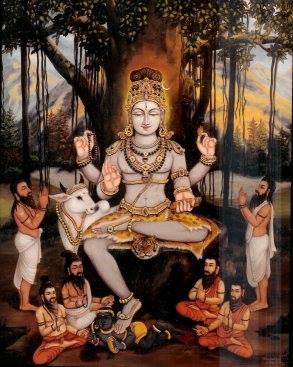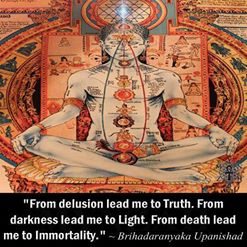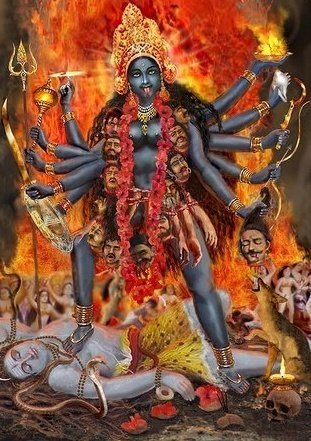I wrote this piece on request by the Adhyatmikta page on Facebook. The admins have added a segment at the end dealing specifically with Tantra gurus while my post was a bit more general purpose.
This was how they led in….
A set of fantastic guidelines penned by Sri Rohit Arya on how to vet a spiritual individual/Guru. Particularly relevant to our times when things are not always as they may appear to be.
POINTERS TO VETTING A SPIRITUAL PERSON

A common question asked by those interested is – How do we know if the person set up as a Guru or spiritual expert is genuine? What do we look for? What are the signs of credibility or warning? This is a long and fascinating topic but before one ventures an answer something must be realized. What you would find acceptable and credible is more about you, your svabhava and your limits of acceptance than it is about gurus in general or particular. With this caveat in place we can move on.
Pointers to vet a ‘Spiritual Person”
Don’t delude Yourself.
Because you wish for a guru or a mentor don’t be credulous or gullible. What parameters are you employing to judge this person? Is there learning present? Intellect? Wisdom? Scriptural Knowledge? Manifest Shakti? Personality that seems spiritual? What is the visible track record and demonstrated credibility of this person and HOW DO YOU DEFINE any or all of the above?
What you seek demonstrates who you are and while you MAY find what you seek it may NOT be what you need to grow spiritually.
Always look for the impact of this person on others. What sort of disciples does this person have? All cut from the same cloth? All of similar ages, or diverse? All from same strata of society or diverse? Are they bright brainy people or buffoons you will run screaming from? Is there excessive deference? Cult like behavior? Are the disciples and students impressive in their own right, or does the Teacher suck all the air in the room out? Are they people with meaningful lives or those who do nothing but spirituality? What do people not inside the group say about them? Do these people have any friends or even life outside the circle? Does the Teacher? Again, the value you place on any or all of these questions reveals who you are.
What is the person like?
Is there bombast and incredible claims or a focus on the teaching? Claims of being reincarnations of famous teachers, being under direct guidance of great Masters of the past and directly chosen by aliens from other worlds to be the channel of light that will bring illumination to all souls, these are not good signs. In any case people claiming to be reincarnations of famous masters is a good enough reason to avoid that place. The parampara, processes and sadhana are obviously useless for they are not producing new enlightened people. The old lot are being endlessly recycled. Nothing could be more insulting to genuine traditions. There is a tiny chance it might be true but in general not a good development. If on their personal pages and groups you find comments like “When I was Veda Vyasa 5000 years back” it is a pretty good reason to clear out pronto. When you find comments that “Yes, I was told yesterday by Vishwamitra that you are indeed Veda Vyasa” you run, not walk for the exit. These are real examples by the way. Actual people said these things and meant every word.
Is the person willing to reveal the lineage or all they all beings from other dimensions? Has the person been instructed to teach by the Guru or has there been a schism and independent dukan has been opened? What does the person say about any of this?
What is the experience of meeting them like? If you meet them do you feel creeped out? Do you feel challenged? Does the talk, the satsangh and the meditation leave you peaceful and energized or drained out? Do you feel calm or agitated? Pay attention to creepiness. No real teacher will ask for illegal and immoral behavior as such. Immoral may have wide notions of interpretation but illegal is the law. Access may be restricted but when you do get it what do you feel? Is that something you wish to repeat or no?
Do you wish for supernatural things to transpire when meeting them? Most of these ‘abilities’ are very simple conjuring tricks. Some of them are the real deal, but they have nothing to do with spirituality per se. In the guise of spirituality are you seeking for a better standard of living? Too many testimonials are just about that. Is the person a miracle monger or a person who has sensible perspectives? Do they promise miracles or do they prepare you realistically for the long hard slog that genuine spirituality requires.? Any set up that guarantees ‘abilities’ or even enlightenment according to a time table, with the option to speed up the schedule according to increase in donations, hmm…
What are the personal behaviors like?
Does the person sit in a plush environment and preach austerity? Between professions and behavior is there a large gap? What are their notions of acceptable behavior for seekers and do the rich and influential get exemptions? How are people in general treated? Is there a deliberate hustle going on? What is the relationship of the teacher and his outfit to money? Lofty proclamations of service go hand in hand with donation demands? What is the treatment of genders? Access and answers, do they adhere to a system or is it all dependent upon whim and size of donation or potential usefulness? Is there a reputation for nastiness, berating students or exploiting them? Are people free to speak up or is everybody cowed and repressed? If there are many rumors of greed and sexual shenanigans they could be spiteful attacks. They could also be true. Pay attention.
What is the group mindset like?
Is there a lot of balderdash masquerading as spirituality? Are you assured you are the reincarnation of somebody famous? Is famous past lives a vital part of everybody’s self image in the place? I think I have met every famous person who ever lived on the planet in six thousand years of history in this short lifetime of over fifty years. There are so many Cleopatras, nobody who was a slave cleaning the floors. In general any group that prioritizes New Cage notions is not going to help in genuine transformations. Foo foo foo notions instead of actual practices that demand time and commitment are dangerous. Is there support and access for all the inevitable issues that will come up or are you at the tender mercies of people so recently hatched the egg yolk has still not dried? Or even worse celebrity “teachers”. When you sign on for the course do they hustle you with classic cult behaviors designed for inclusion, flatter you that you are now a special person with access to unique knowledge and also isolate you from the world? Are authentic practices being taught which have grounding in dharmic traditions or is it all wind usually pulled out of the rear end? What is the level of commitment expected and are standards rigorous?
So much for the approached.
Now a brief word for the approachee. CAVEAT EMPTOR. BUYER BEWARE.
While that is a perfectly valid position to take – don’t be a jerk. You are seeking and the other party is under no obligation to fulfill the terms of the imaginary contract you make with them in your head. You may have many expectations, but it is not the job of the Teacher of guru or the organization to fulfill any of them. All of them have their own unique ways of dealing with things. If you do not like it or disagree, move on.
If you have certain mental image of how a spiritual teacher should be and the person violates that, the flaw may be in your expectations. It is a great mistake to assume only the phate haal kangal types are the genuine spiritual people and all the others are less than… If you insist on diet and brahmachanrya filters too well that is your right. Insisting on a certain age, gender, learning, attractive appearance all of these are completely beside the point of spiritual transformation. The most unexpected might be the most useful. It is also better to have full access to an unknown guru than an occasional glimpse from afar of a person with millions of followers. Access cannot be overestimated, but it has to be earned and deserved, not demanded straight off the bat.
A person who is unexpected, who shakes up your mental rigidity, who holds you even as you feel your mental constructions of self dissolve, that person can certainly help you, even if he or she is not the guru proper. It is not so well known that from the point of view of rnanubandhana it might well be that you will meet a famous and powerful teacher but he has nothing to give you while a much lesser person can give you everything of his attainment. Don’t be a fool about this. Don’t have ego issues that I am smarter or more educated. Perhaps. But the other person may have something valuable you don’t.
To expect endless access, endless answers and all for free while you make up your mind may seem very reasonable to you but the other side may just see their time being wasted. Value is a two-way street. If perceived that you are there merely to take, many of them will correctly shut you out. Just as you will assess and evaluate, you will be judged too. If found wanting, it may not always be because the other side did not appreciate the glorious blessings you bring to all existence by merely existing.
Stay grounded, stay alert and best of all is to trust in the Divine. When it is time you will be guided to the Teacher you require.
* * * * * *
A few additional points from the Page admins:-

1. To add to this, when it comes to Tantrica Gurus the bar is both strict yet simple. The primary idea of Tantra is a bifurcation into the major path and the minor path, one that leads to a communion and permanently transformative vision of the Ishta Devata, or an attainment of specific abilities. Unlike other paths Tantra does not rescind or tell you that siddhis are not be attained, if a seeker is so tuned, or a guru thinks fit, s/he may certainly do sadhana to acquire them. Their use of course is a matter of wisdom and guidance. In any case the point is that Siddhis are perfectly legitimate in this path. So, when a seeker approaches a Tantric master one must be clear on what exactly one is looking for. If the highest is the goal, attainment of communion and the resultant transformation, then find out how many people have been able to attain the same under the direction of the said Guru, test them, test them well and thoroughly. Otherwise if there are claims of supernatural ability then ask for a demonstration. A genuine Guru will of course never display a siddhi merely to make a demostration of it, however if s/he does possess siddhi-s it will be put to use someday or the other, when circumstance so demands. Be patient and wait and observe. Without an external manifestation all claims of supernatural abilities are just that, claims, with no basis. If someone claims to have communion with a deity, then too observe and watch. For each deity has his or her unique nature and abilities and those will be reflected in the individual. This is a natural stage of sadhana, rare stage no doubt but a sadguru is also a rare term not to be trifled with in casual manner. Unless the bar is set clearly in the mind, and judged accordingly, one is most likely to get disillusioned in time.
2. Ramakrishna Paramhamsa used to say that always observe a spiritual man when he is alone, and when he is in public. Is there a difference in behaviour? Is there a tendency to hide things – that’s a trigger for the necessity to hide or create projections is a certain sign that there is some agenda in the mind. An agenda of course is a normal human thing, but impossible when a mind is truly enlightened. The Self has no agenda, neither does a man who has really attained to a transformative and ulimate communion with a Devata – specially one of the major devata-s.
3. On being asked where and how does one judge true enlightenment, Sri Ramana Maharishi used to say you can only figure out an enlightened man if you are yourself in that state, otherwise you will only speculate. Good advice to remember at all times. In other words, if one follows common sense and applies the fundamental ideas of spirituality, one maybe easily able to tell who has NOT reached the ultimate stage. But it is impossible to say with certainty who has actually reached the ultimate stage, unless one has reached the Self himself/herself. Then it’s a different matter anyway.
4. Always judge an individual, spiritual or otherwise, by their actions and the gaps between their words and actions. Actions are what makes a man, words – well even politicians are good at.
5. Ramakrishna once sagaciously adviced one of his core disciples who was cheated at the local market,” I asked you to be a devotee, not a fool.” Prescient advice and valid for all times.
Sri Guru Rohit Arya is the Founder of the Arya Yoga Sangha and a Lineage Master in a Kundalini path of Yoga.




































